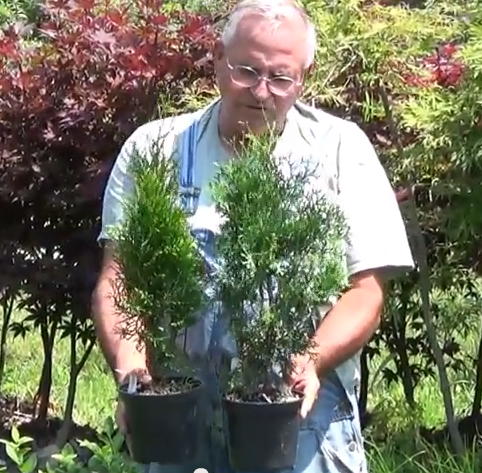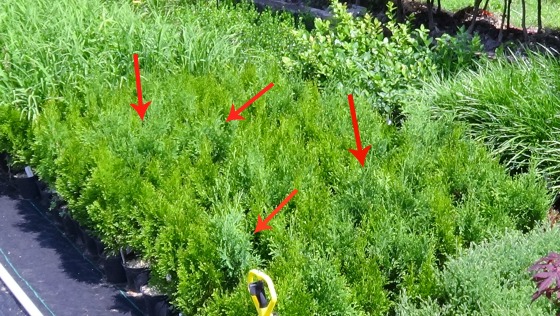Mike and I were walking through the nursery yesterday discussing what we wanted to shoot our next “Mondays With Mike” video about. As we walked past a row of plants in the container area Mike said, “Hey Amber, check out the arborvitae”. As I walked closer to the grouping of evergreens tagged as Arborvitae ‘Emerald Green’ I noticed a slight color variation.
Uh Oh. Something is wrong.
Most arborvitae have a deep green coloration. Emerald Green Arborvitae have a slightly lighter color with a tinge of gold to it. About 3/4 of the grouping matched that description, but scattered amongst them were are few who’s color looked “off”. They had the deeper green color typical of other arborvitae.
As we pulled a plants out of the group, it was clear that the shape of the plants were different as well. Emerald Green Arborvitae are sought after for their shape and growth habit. As I’ve heard Mike say before:
All pyramidal Arborvitae are not created equal!
Emerald Green Arborvitae have a distinct narrow shape. They grow tall, but not too tall- maybe 10-12 feet. They are dense and keep a tight spread of about 3 feet.
Now something like Dark Green American Arborvitae will get 15-20 feet. They are less dense and will spread to 4 or 5 feet.
Both arborvitaes are similar, but if you were planting a hedge and accidentally interchanged one or two of them the difference would very noticeable. This is important because Emerald Green Arborvitae is something that landscapers and homeowners who come to our nursery ask for by name. We’ve worked hard to build a relationship with them. They trust that they will get good advice and quality plants from us. That is what keeps them coming back. Bad advice or mislabeled plants will break that trust.

The shape of these plants is quite different. The Emerald Green Arborvitae on the left has a much more compact and defined shape than the arborvitae on the right.
Both of these arborvitae were potted up last summer. They came from two different suppliers and were sold as Emerald Green Arborvitae. A large order came from a reputable wholesaler. The smaller group was purchased from a backyard grower. In the process of putting down nursery ground cloth and re-arranging plants for sale, the two groups were combined. At that time they looked the same. There was no cause for concern. A few months later…look at the difference!
This is an important lesson for all plant propagators!
It is so important that you know the exact variety of the plant that you are taking cuttings from. It is never okay to guess. Just because a plant looks like one specific variety does not mean that it will preform like that variety. Arborvitae is a great example of this. Virginia creeper, poison ivy and ginseng all have similar leaves…but act very differently when ingested! Just as you would be sure not to eat an unknown plant, you must be absolutely, positively sure of which plant you have before you propagate it.
A funny thing about us plant enthusiasts: We love to identify plants. We point out the Chinese dogwood in the park, comment on the purple leaf sand cherry outside the bank and stop to admire the euonymus outside of the Olive Garden. We know our plants. Even so, we cannot in good faith look at the weigela in our neighbors yard and declare it a ‘Java Red’. There is no definite way to determine the exact variety of a particular plants just by looking at it. It is never okay to guess. You cannot take cuttings from that weigela, root them and then sell them as Java Red Weigela. For all you know, it could be a patented variety and you just found yourself in a heap of legal trouble for propagating it without permission.
We are are certain that the seller did not intentionally send us the incorrect variety, but its important that we bring it up. Mistakes like this can cause a huge chain reaction if they go unnoticed. Imagine this scenario: We get 50 incorrectly labeled plants and take cuttings from them. Then we have hundreds of incorrectly labeled plants rooting. Let’s say 400 of them root. We sell 300 to 5 other growers and keep the remaining 100 to take more cuttings from. The other growers take cuttings.…now there are thousands of incorrectly labeled plants circulating. It would literally be plant propagation madness!
If you’ve not read Mike’s warning yet The Most Important Thing You Need to Know Before Starting Your Backyard Nursery its worth checking out. Click here to read it.

Hi Mike,
I know you say plants need to be labeled, but I noticed this year (2016) that plants at big box stores and Walmart have generic labels, like “succulent,” “daylily,” “geranium,” etc. Have the rules changed on identifying plants?
Anne,
No, the rules have not changed, all plants should be properly labeled and as the propagator you should at least know the botanical name of what you are propagating.
Mike: I propagate and donate elderberry plants to the Utah Division of wildlife resources ((DWR) and the Forest Service. I do root and hardwood cuttings. The DWR has requested that I add the plants listed below. I was wondering If I can use the methods i currently use to propagate these new plants.
They Are: bitterbrush, big sage,mountain mahogany,curlleaf mahogany,currant,wood’s rose, buffaloberry and hackberry.
Any advice you can offer would be appreciated.
thanks,
bart
Bart,
A lot of plants root as hardwood cuttings but it does take some time. I’d say that 95% of plants except tree will root quickly and easily, in a matter of weeks done as softwood cuttings during the summer. Here in zone 5 we start out softwoods in early to mid June and just keep on sticking them through August using this system http://mikesbackyardnursery.com/mikes-plant-propagation-kit/
I am on an online retailer functioning as a dropship model business. I am considering taking on inventory, and plants seem like a bunch of fun. This post has me wondering now. If you are selling a plant, but don’t know what variety or hybrid it is do you need to know what it is, or can you say it is a maple tree (for example) and outright claim you are uncertain what variety or species it is? Is that still legal?
Mike,
I wanted to know how you propagate coffers like junipers or pines? Also, can you do cuttings of cedars like Japanese cedars?
Dave
Do you sell plants in the fall? If so, when do you pot them? Mine are in the ground and want to sell some.
Michael,
How can I buy some Japanese Maples from you?
Sang Lee
Sang,
I only sell locally but many of our backyard growers have and often ship Japanese maples.
Hey Mike, I want to ask you if you know about a yellow colored moss like fungus that gets on filbert trees and tends to choke off their growth ? It is also starting to get on my fruit trees and I would like to know what to use to get rid of it. Thanks, Les
Les,
I had some moss on my Filberts, but I’m pretty sure it was from the mulch I had around the base of the tree as it only appeared at ground level. That’s really all I know about it.
What if it is a beautiful plant but you have no positive way to narrow down the identity? Can you use a disclaimer and just call it “Arborvitae”?
I just took some cuttings (for my own use) on a “weeping willow”. Beyond it being a “weeping willow” I cannot identify it.
I have (here in Tennessee) a good many Chestnut Oaks in my 10 acre woods. They produce 1000’s of large acorns that spout into a sea of seedlings in spring. I think the Chestnut Oak is a beautiful and splendid tree. I thought about gathering them and sprouting them in spring – just to offer as bare root seedlings by mail. They are Chestnut Oaks. What more can you say about them?
“Nathan” (my 12 YO grandson/partner) and I got started a few months ago by rescuing about 80 tiny Japanese Maple seedlings (this past spring) from our yard – that had volunteered from seed that grew on my trees. They are all beautiful (red) and growing in 1 (trade) gallon pots. Some of them are 12″ or more high now.
We are just getting started with our “hobby nursery” and have not sold anything yet. I have no intention to sell anything until I know that I am doing everything legally. (we bought your book online and printed it and bound it in a spiral binder).
Charles
Charles,
In most states you are required to tag your plants with the known and accepted common name. In the wholesale market you absolutely must have the full botanical name. So it’s much better if you start with plants that are properly labeled. That way you can reproduce them over and over and never regret that you started with the wrong plants in the first place. You only have to buy one properly labeled plant, one time, in order to do this correctly.